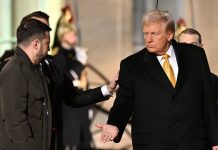SEOUL, South Korea (Reuters) – North Korea tested an ICBM on Thursday hours before South Korean and Japanese leaders met in Tokyo.
North Korea has also conducted its first ICBM test in a month and its third weapons test this week, and North Korea continues with joint South Korean and US military exercises it sees as rehearsals for its invasion.
According to South Korean and Japanese estimates, the missile flew about 1,000 kilometers (620 miles) at a maximum altitude of 6,000 kilometers (3,730 miles) during her 70-minute flight. This is similar to the flight details of his February launch of another of his ICBMs, which experts say could reach deep into the continental United States.
After being launched in a steep trajectory, the missile landed in the waters between the Korean Peninsula and Japan, apparently to avoid neighboring countries. Japan said the missile landed outside its exclusive economic zone and there were no reports of damage to ships or planes.
The Yun-Kishida summit, scheduled for Thursday afternoon, marked a major step forward for the Yun administration last week to restore bilateral relations strained by Japanese colonial rule on the Korean peninsula from 1910 to 1945. South Korea’s plan to use local funds to compensate some of the victims of colonial-era forced labor, without donations from the Japanese companies that employed them, was arranged by a strong domestic force. Although met with opposition, it reflects Yoon’s determination to promote security cooperation between Seoul and Tokyo.
North Korea’s pursuit of expanding its nuclear arsenal has prompted South Korea and Japan to strengthen their security partnership with the United States. communities were issued an evacuation warning and trains were stopped. Under Kishida, Tokyo also largely violated postwar principles of pure self-defense and launched a new national security strategy that included the goal of acquiring first-strike capabilities and cruise missiles to counter the growing threat from North Korea.
It was widely expected that North Korea would continue to conduct a series of aggressive weapons tests. Chairman Kim Jong-un last week called on the military to prepare for what he described as “desperate preparations for war” by his country’s rivals, citing large-scale joint exercises between the United States and South Korea that began on Monday.
North Korea has long argued that US-South Korean military exercises are evidence of its hostile policy toward North Korea, but the US and South Korea have said they have no intention of invading North Korea. Many experts say North Korea is using rival military exercises as a pretext to boost its nuclear capabilities and press the United States to make concessions, such as easing international sanctions. North Korea also launched cruise missiles from submarines this week and sent short-range ballistic missiles across its territory into the eastern seas. bottom. State media described it as a mock attack on an unspecified South Korean airfield.
The ongoing exercises between the United States and South Korea are scheduled to last through March 23 and include computer simulations and live-fire exercises. Experts had expected North Korea to step up its testing activities during the exercises.
Top nuclear envoys from Seoul, Washington and Tokyo discussed North Korea’s intercontinental ballistic missile launch over the phone and agreed to coordinate to unify the international response to North Korea’s weapons activity, according to the Seoul Ministry of Foreign Affairs.






